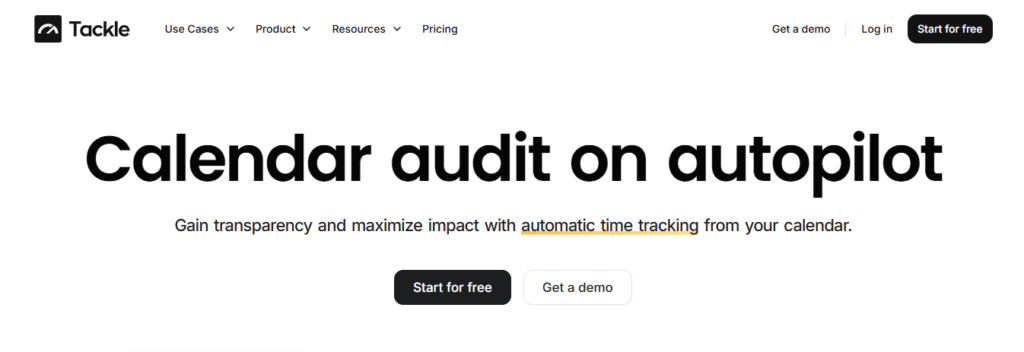Stuck staring at a slow afternoon, watching the clock inch forward while your to do list grows? Small habits and more innovative task planning can turn that drag into steady momentum, which is why the best free habit tracker app matters when you want to steal back your attention and make hours feel shorter. Looking for practical ways to beat boredom, improve focus, and reduce task switching? This article provides proven strategies for making time go faster at work, including chunking, task batching, timed breaks, and attention resets.
To put those ideas to work, Tackle’s automatic time tracking software quietly records where your minutes go and highlights the pockets you can reclaim for focused work. Use it to spot distractions, set timed sessions, and keep a cleaner workflow without guesswork.
Why Time Seems to Drag at Work

Time at work bends around what you pay attention to. When you stare at the clock, you build the clock into your experience. Your mind fills empty minutes with awareness of minutes, and each one feels larger than it is. Which of these sounds familiar right now?
Repetition Flattens Experience
Repeated tasks reduce novelty and sharpen focus on how long a task will last rather than what the task requires. Low challenge and predictability drain mental bandwidth, making moments feel longer. When did you last lose track of time because a task grabbed you?
Emotions Change Pace
Anxiety and boredom both stretch time, though for different reasons. Anxiety makes you scan for problems and count waiting minutes. Boredom withdraws attention from the task and parks it on the clock. Which emotion pulls at your attention most often?
Body State Matters More Than People Admit
Fatigue, low blood sugar, poor lighting, and bad posture can all slow down your processing. Your brain then treats minutes as heavier. Minor physical fixes change perceived speed quickly. Have you tried getting up or adjusting the light?
Related Reading
- Happy Friday Meme
- How Many Work Weeks in a Year
- Friday Memes for Work
- Leadership Interview Questions
- How Many Weekend Days in a Year
- How Many Working Hours in a Month
14 Proven Strategies to Make Time Go Faster at Work

1. Stop Watching The Clock
Looking at the time keeps your attention locked on passing minutes, which makes each minute feel longer. Cover the clock on your screen, put your phone away, remove your watch, or tape over that office clock face.
Replace constant checking with a single timed alarm or a calendar reminder to help you switch tasks without tracking every minute. When you stop scanning for time, your attention can shift to work, and the work will claim the minutes instead.
2. Make a Schedule
A clear schedule gives each hour purpose and reduces empty mental space where boredom grows. Schedule slot-specific tasks, meetings, and breaks into your calendar to keep attention focused.
Use time blocks for concentrated work and short recovery periods to keep cognitive load balanced. Busy, purposeful attention makes time pass faster because you’re engaged instead of waiting.
3. Engage Your SNS
The sympathetic nervous system raises alertness and shortens subjective time when you meet a challenge. You don’t need extreme stress; a brisk walk, a quick set of bodyweight exercises, a timed puzzle, or a short talk to a colleague will increase arousal enough to alter time perception.
Use controlled challenges before intense periods of focus to prime alertness and maintain high attention without burning out.
4. Enter Flow State
Flow requires a clear goal, immediate feedback, and a task that matches your skill. Set one specific, stretchable target for a session, remove distractions, and ensure you’re physically ready, hydrated, fed, and comfortable. When your skills meet a challenge, attention narrows and time perception distorts; you stop counting minutes because you’re absorbed in doing.
5. Add Variety
Monotony flattens perceived time; variety reengages attention and memory systems. Rotate between creative work, analytical tasks, short meetings, and passive tasks so the brain encounters new demands regularly. Change tools, formats, or the order of functions to reset attention. Activity diversity supports cognitive functioning and makes the day feel shorter.
6. Focus on Tasks With Progression
Tasks that show steady progress give immediate feedback and maintain engagement. Break projects into measurable steps so each action produces a visible result. Use progress bars, checklists, or version saves to show forward motion. When you see advancement, motivation stays high and attention remains on work rather than on the clock.
7. Use a To-Do List
A written list reduces startup friction and stops your mind from rehearsing future chores. Prioritize the list so you tackle the toughest items first, then capitalize on the motivation from early wins.
Tick items off to get minor dopamine hits that keep you engaged. The list removes ambiguity and helps you slip into sustained work faster.
8. Break Time Into Blocks
Divide your work into fixed blocks, such as 20 to 50 minutes, with short breaks in between. Known endpoints reduce anxiety and make it easier to commit attention fully for a set span. Try the Pomodoro method or customize block lengths to your attention span. Anticipating the next break helps the brain sustain focus and shortens subjective time.
9. Enjoy Socializing and Share Your Work
Social interaction injects variety and keeps morale high, which speeds up the passage of time. Pair on a task, run a short video check-in, or swap quick status updates with a teammate. If you work remotely, schedule brief co-working calls to recreate the social cues of the office. Social exchange gives the day texture and keeps attention engaged.
10. Split Unpleasant Tasks
Large, aversive tasks drag because they loom as a single long ordeal. Break them into 20 to 30-minute segments and spread them across the day. Do the unpleasant chunks early when willpower is fresh, then reward yourself after each segment. Small, repeated wins reduce dread and keep mental energy available for other work.
11. Change Your Work Scenery
Where you work signals how the brain should behave. Declutter your desk, rearrange your setup, or move to a different room or a café for a session.
Novel surroundings provide fresh stimuli that reset attention and reduce boredom. Micro changes in the environment give your routine a jolt and help the hours pass with less friction.
12. Bathe Your Workspace in Blue
Cooler, blue-leaning light reduces anxiety and can shorten perceived time compared with warmer red light. Swap a lamp for a cool white or blue-toned bulb during daytime work sessions to calm the body clock while keeping alertness up. Avoid heavy blue-light exposure late in the evening to protect sleep quality.
13. Think Positively
A constructive outlook changes how you experience time. Play music that lifts you, frame tasks as accomplishments rather than chores, and use small motivational cues on your desk.
Track your mood patterns to identify what boosts your focus, and then repeat those triggers. A better mood raises engagement and reduces the felt length of the workday.
14. Reward Yourself
Set clear, small rewards for completing blocks or milestones so motivation stays linked to action. Rewards don’t need to be significant; a five-minute walk, a favorite snack, or a short break to read something you enjoy can be enough. Schedule rewards as part of your plan so attention has a payoff and tasks gain urgency, which helps time pass.
Seamless Time Tracking with Tackle
Tackle revolutionizes time tracking with seamless calendar integration that eliminates manual logging and captures categorized time automatically. Start using our automatic time tracking software for free with one click today!
Creating a Productive Work Environment

Treat every person with courtesy and expect the same from everyone. Lead by example on the sales floor and behind the counter. Implementing harassment prevention training is necessary to ensure staff understand the boundaries of acceptable behavior and know how to report issues.
Give workers predictable schedules, fair pay, and consistent enforcement of rules to reduce stress and keep attention on the job rather than the clock. When employees feel respected they focus on serving customers and solving problems, which shortens the perceived length of a shift and cuts down on clock watching.
Teamwork: Make the Shift a Shared Mission
Set clear, measurable team goals for sales, cleanliness, or customer wait time and track progress together. Use short daily huddles or a quick shift checklist to align priorities and minimize tasks that waste time.
Encourage pairing on tasks so novices learn from veterans and so repetitive jobs break into social, cooperative blocks. Gamify targets with small rewards, timed challenges, or rotating responsibilities to create momentum and help people get into a flow state where work moves faster.
Training: Invest in Skill Growth That Keeps Minds Moving
Run a gap analysis to find where skills fall short of your store goals and then build short, focused learning modules. Use on-the-job coaching, microlearning clips, and shadow shifts so employees practice while serving customers.
Teach techniques like task batching and using timers, such as the Pomodoro method, to help staff break large jobs into 25 minute blocks with short breaks. Offer cross-training so people can rotate through roles, which reduces boredom and keeps attention sharp.
Communication: Open Channels That Cut Friction and Clock Watching
Ask specific questions during one-on-one meetings and team huddles about customer feedback, compliance, and ideas for improving service. Create a simple suggestion process and act on reasonable ideas quickly to demonstrate that feedback matters.
Share daily priorities so workers know what to do first and do not waste time guessing. Clear direction and quick feedback reduce interruptions, giving employees the focus needed to hit flow states and make time feel like it moves faster.
Opportunity: Show Paths That Turn Shifts Into Careers
Advertise and promote from within, plan and map clear steps for advancement so employees see how effort leads to new roles. Offer training for newly promoted staff and assign mentors for the transition.
Provide stretch assignments, short leadership tasks, or special projects so people can build skills and break monotony. When work links to future possibilities, motivation rises and boredom falls, which speeds perceived time on the job.
Related Reading
- How Many Saturdays Are in a Year
- Funny Timesheet Reminder Meme
- Team Lead Interview Questions
- Submit Your Timesheet Meme
- Cute Friday Memes
- Recruitment Campaign
Start Using Our Automatic Time Tracking Software for Free with One Click Today

Tackle connects to your Google or Outlook calendar and captures time automatically so you do not type entries or remember timers. The extension watches your calendar events and browser activity, classifies blocks of time, and fills in your timesheet without extra work. That removes the administrative drag that pulls focus away from deep work.
Calendar Integration That Keeps You Focused
Calendars become the single source of truth. When meetings and blocks are logged automatically, you spend less time switching between apps and less time guessing where your hours went. The result is more uninterrupted stretches for focus, which helps you reach a flow state and makes hours feel shorter.
Smart Tagging And AI-Powered Automation That Follows Your Rules
Create custom tags that match your role and goals. Use rules to route recurring events into project buckets, mark client work, or separate heads-down time from customer-facing work. The AI-powered automation learns patterns, enabling the system to handle repetitive sorting without constant corrections, which in turn reduces the tedium that makes the day drag.
Flexible Reporting That Surfaces What Matters
Dashboards show where time goes by team member, project, and client, and reports let you slice by billable work, strategy time, or support tasks. When you can spot long stretches of context switching or low-value meetings, you can redesign days to favor longer, focused blocks and to schedule variety that prevents boredom.
Intelligent Time Capture Right In Your Browser
Tackle records active tabs and ties browser activity to calendar events so you can see which websites and tools consume your attention. That visibility helps you remove distractions, batch small tasks, and create micro routines that speed task completion.
Quick micro breaks then restore energy before attention fades.
How This Helps Make Time Go Faster At Work
What makes time feel slow is low engagement and frequent interruptions. Tackle removes busy work, gives clear feedback on where attention flows, and supports planning for more extended uninterrupted periods.
Use the data to schedule smaller wins, alternate high and low intensity tasks, and protect blocks for focused work. These tactics change your perception of time and improve productivity.
Who Benefits And How Teams Use It
Executives use the reports to match leadership effort to strategy. Team leads identify and rebalance workloads. Customer-facing professionals track client time and improve responsiveness without manual timers. The same system supports billing, performance reviews, and resource planning while staying invisible to the daily flow.
Quick Setup That Actually Works
Install the extension, connect to Google or Outlook, set a few tags, and turn on automations. The default rules cover common meeting types, so you see value fast. Try the one-click free plan and see how fewer admin tasks and clearer time signals lead to more productive days.
Want to try an example rule or see a report built for your role? Which job function should I map tags for first?
Related Reading
- Unique Questions to Ask Leaders
- How Many Hours Do People Work in a Year
- How Many Days in the Year Without Weekends
- Benjamin Franklin Schedule
- Recruitment Campaign
- Payroll Reminder Meme
- Standard Work Hours in a Year

